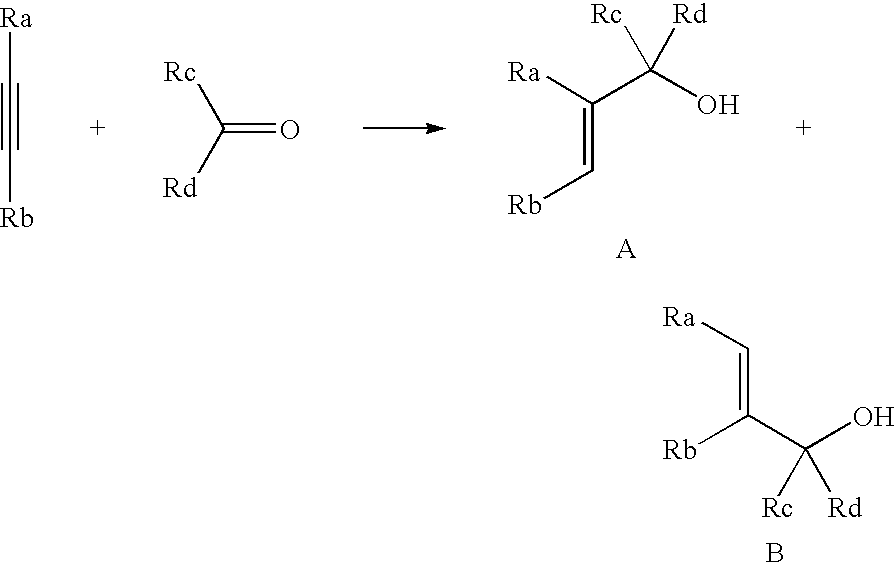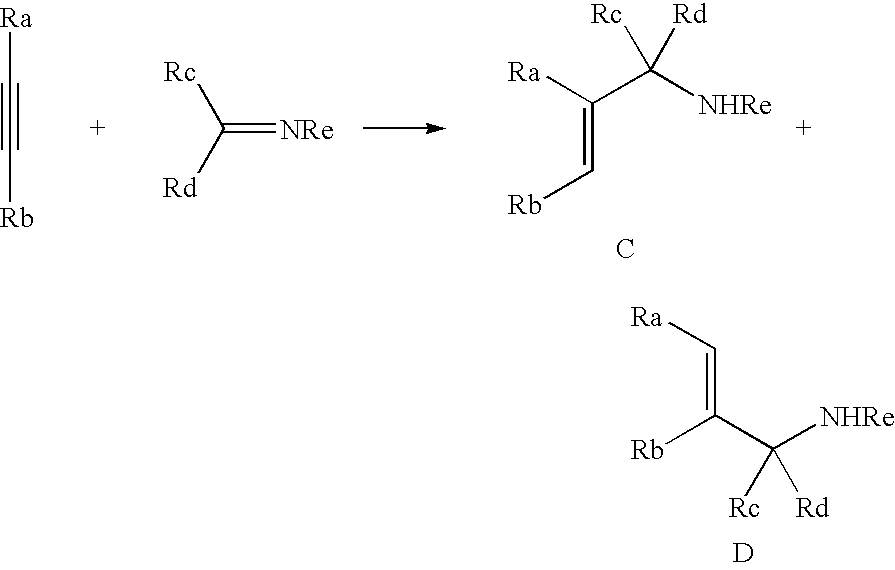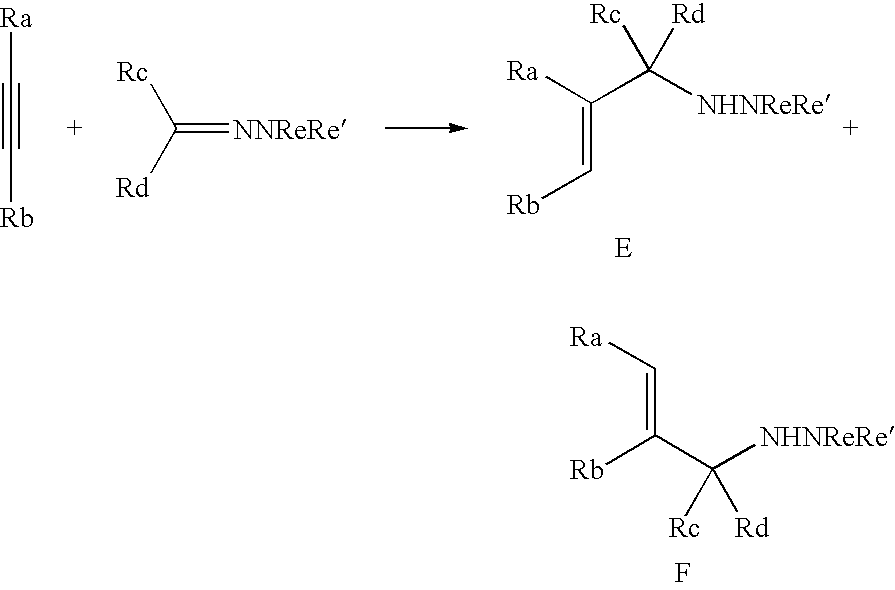Titanium catalyst and organotitanium reacting reagent, production thereof, and reaction thereby
a technology of organotitanium reacting reagent and titanium catalyst, which is applied in the direction of catalytic reaction, catalytic activation/preparation, chemical/physical processes, etc., can solve the problems of limited catalytic use of titanium compounds for coupling reactions of less reactive molecules, and too expensive zirconocene and titanocene for industrial us
- Summary
- Abstract
- Description
- Claims
- Application Information
AI Technical Summary
Benefits of technology
Problems solved by technology
Method used
Image
Examples
example 1-1
To 0.30 ml (1.0 mmol) of tetraisopropoxytitanium and 5 ml of ethyl ether solution containing allyl bromide (1.0 mmol) was added dropwise at −50° C. 1.67 ml of 1.2M ethyl ether solution containing isopropylmagnesium bromide (2.0 mmol). Upon stirring at −50° C. to −40° C. for 1 hour, the reaction liquid turned from yellow into brown. To the reaction liquid was added 0.071 ml (0.7 mmol) of benzaldehyde at −45° C. to −40° C. The temperature was raised to −10° C. to 0° C. over 30 minutes. With 5 ml of 1N hydrochloric acid added, the solution was heated to room temperature and separated into layers. The organic layer was washed with a saturated aqueous solution of sodium hydrogen carbonate. After drying with anhydrous magnesium sulfate, the solution was freed of solvent by vacuum distillation. The residues were purified by silica gel chromatography. Thus there was obtained 97 mg of 1-phenyl-3-buten-1-ol (94% yields based on benzaldehyde).
examples 1-2 to 1-14
The procedure of Example 1-1 was repeated except that the allyl bromide, tetraisopropoxytitanium, and isopropylmagnesium bromide were replaced by those compounds shown in Table 1. There was obtained 1-phenyl-3-buten-1-ol in different yields as shown in Table 1.
TABLE 1Yields ofAllylTitaniumGrignard1-phenyl-3-Examplecompoundcompoundreagentbuten-1-ol (%)1-1X = BrTi(O-i-Pr)4i-PrMgBr941-2BrClTi(O-i-Pr)3i-PrMgBr921-3BrCl2Ti(O-i-Pr)2i-PrMgBr121-4BrTiCl4i-PrMgBr201-5BrTi(O-i-Pr)4i-PrMgCl931-6BrTi(O-i-Pr)4EtMgBr721-7BrTi(O-i-Pr)4n-PrMgBr931-8ITi(O-i-Pr)4i-PrMgBr961-9ClTi(O-i-Pr)4i-PrMgBr921-10OAcTi(O-i-Pr)4i-PrMgBr611-11OC(O)OEtTi(O-i-Pr)4i-PrMgBr741-12OPhTi(O-i-Pr)4i-PrMgBr891-13OTsTi(O-i-Pr)4i-PrMgBr571-14OP(O)(OEt)2TI(O-i-Pr)4i-PrMgBr83
example 1-15
To 0.90 ml (3.0 mmol) of tetraisopropoxytitanium and 5 ml of n-butyl ether solution containing allyl bromide (3.0 mmol) was added dropwise at −78° C. 6.2 ml of 0.97M n-butyl ether solution containing isopropylmagnesium bromide (6.0 mmol). After stirring at −50° C. to −40° C. for 1 hour, the reaction liquid was given 0.21 ml (2.1 mmol) of benzaldehyde and heated to 0° C. over 30 minutes. With 10 ml of 3N hydrochloric acid added, the solution was heated to room temperature and separated into layers. The organic layer was washed with a saturated aqueous solution of sodium hydrogen carbonate. After drying with anhydrous magnesium sulfate, the solution was freed of solvent by vacuum distillation. The residues were purified by silica gel chromatography. Thus there was obtained 252 mg of 1-phenyl-3-buten-1-ol (81% yields based on benzaldehyde).
1H-NMR, δ: 2.42-2.51 (m, 2H) 2.56 (br s, 1H) 4.63 (t, J=6.4 Hz, 1H) 5.04-5.19 (m, 2H) 5.67-5.84 (m, 1H) 7.18-7.39 (m, 5H)
13C-NMR, δ: 43.7, 73.3, 11...
PUM
| Property | Measurement | Unit |
|---|---|---|
| temperature | aaaaa | aaaaa |
| electrophilic | aaaaa | aaaaa |
| valence | aaaaa | aaaaa |
Abstract
Description
Claims
Application Information
 Login to View More
Login to View More - R&D
- Intellectual Property
- Life Sciences
- Materials
- Tech Scout
- Unparalleled Data Quality
- Higher Quality Content
- 60% Fewer Hallucinations
Browse by: Latest US Patents, China's latest patents, Technical Efficacy Thesaurus, Application Domain, Technology Topic, Popular Technical Reports.
© 2025 PatSnap. All rights reserved.Legal|Privacy policy|Modern Slavery Act Transparency Statement|Sitemap|About US| Contact US: help@patsnap.com



